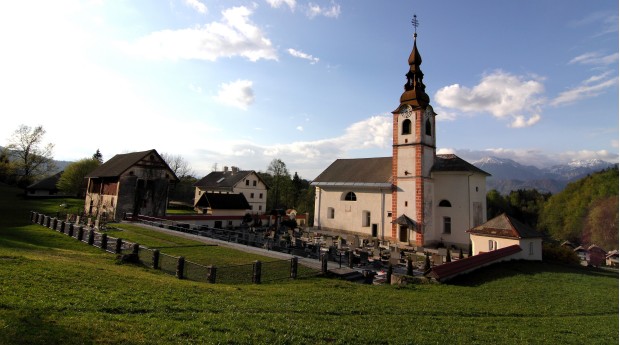- KEYBOARD NAVIGATION
- DISABLE ANIMATIONS
- HIGH CONTRAST
- BLACK & WHITE CONTRAST
- INCREASE TEXT SIZE
- DECREASE TEXT SIZE
- MARK TITLES
- MARK LINKS
- UNDERLINE LINKS
The Church of the Holy Trinity
Take the steps leading up from the village, visit the nearby Sextons' Museum House, and marvel at the wonderful views.
The Church of the Holy Trinity above the iron forging village of Kamna Gorica is opulently decorated. Its position above the village affords excellent views of the village, across woodlands and all the way to the peaks of Stol and Begunščica in the Karavanke range.
In close proximity to the church is the Sexton’s Museum House, which houses the local museum.
The church can be reached on foot from the central village square by the linden tree. The stone stairway, with some 100 steps, begins between the houses numbered Kamna Gorica 37 and 48. A road leads to the church from the western side of the village.
The exterior
The exterior of the church is adorned by original frescoes. On the eastern facade there is a fresco of the Holy Trinity, whilst on the northern facade there is a depiction of Jesus meeting his mother. Originally on this side there was also a fresco of Women at the Cross, which was moved to the eastern facade.
To the left of the entrance door to the church is the grave of the Toman family with the last record of the poet, politician and patriot Lovro Toman. Opposite the entrance to the church is a memorial to the victims of World War I.
The interior
The interior has a rectangular floorplan and is fitted and painted in the neo-Renaissance style. The main altar dates from 1863 and is the work of Janez Vurnik, a stonemason and artist from Radovljica. In the niche there is a painting of the Holy Trinity, whilst the side altars feature statues of St. Andrew, St. Peter, St. Paul and St. Bartholomew.
Originally there were only two side altars in the church with pictures depicting St. Barbara, the protector of miners, and St. Florian, the protector of firefighters and the intessesor against fires. The paintings are the work of Valentine Metzinger, the most important Baroque artist in Slovenia. On the altar tables of the side altars there are paintings of the Mother of God, the work of the local artist Matevž Langus, and St. Joseph, possibly also the work of the same artist. When the church was enlarged in 1754 an additional altar of the Immaculate Heart of Mary was added, as well as the altar to St. Joseph – both the work of Janez Vurnik dating from 1860. The pulpit dates from the late-Baroque period.
The church organ is the work of the brothers Ignac and Ivan Zupan, organ masters, who lived and worked in Kamna Gorica.
The wrought iron chandelier is the work of the Kropa artistic blacksmith Joža Bertoncelj.
Related news
In the 200-year-old house there is a preserved black kitchen and an exhibition about famous villagers and notable sights of interest in Kamna Gorica.
A picturesque iron forging village beneath the Jelovica plateau with numerous water troughs and small bridges, which has earnt it the name 'Mini Venice'.
A fascinating circular trail from Radovljica over the Sava river to the ruins of Lipnica Castle.




